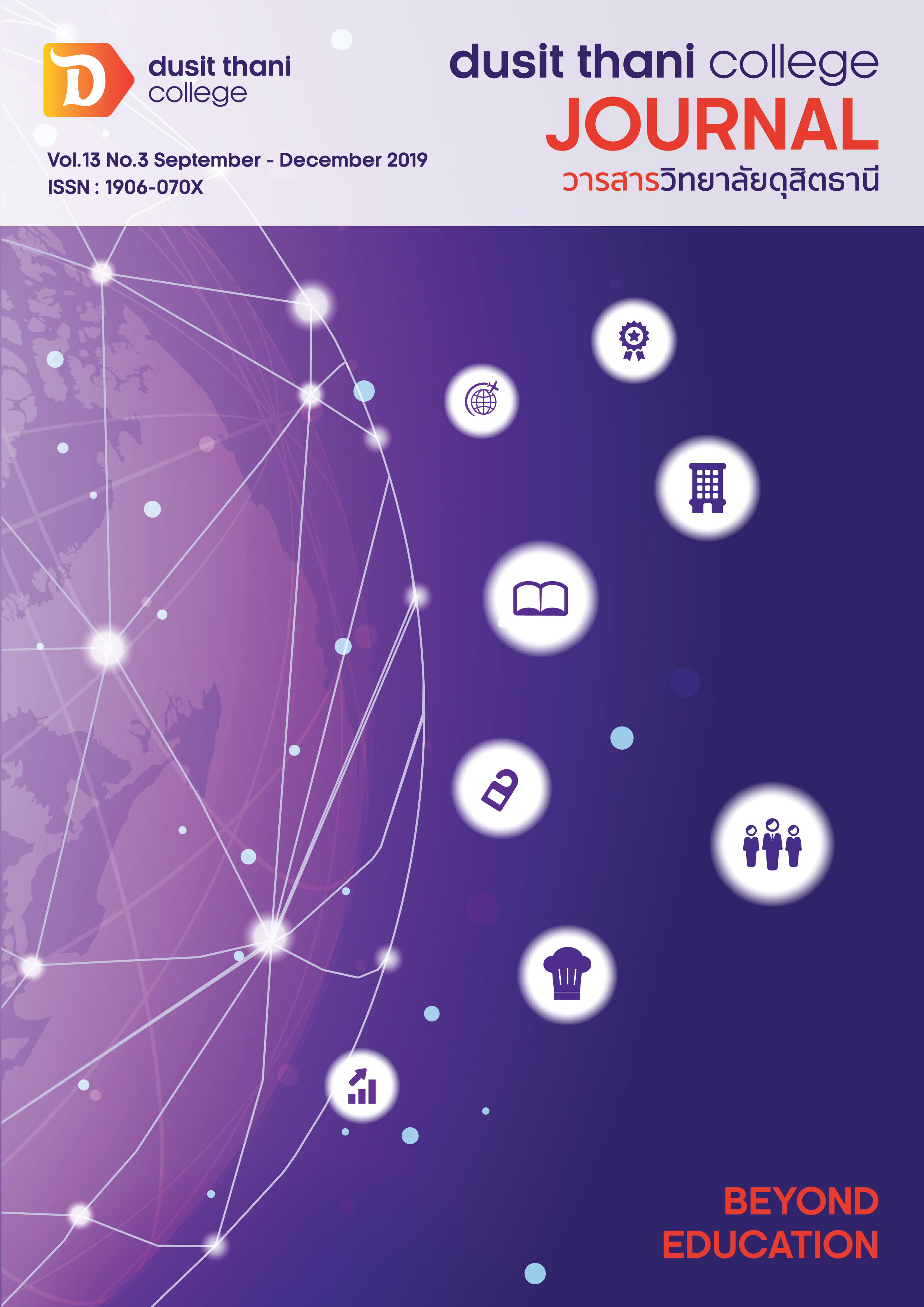Perceptions Towards Andragogy and Self-Directed Learning Readiness of Thai Learners Learning English with Two Different Types of Motivation
Main Article Content
Abstract
This research aims to study the perceptions towards four assumptions of andragogy among Thai learners learning English with the instrumental and the integrative motivation and to investigate their level of self-directed learning readiness while learning with these two types of motivational approaches. Third and fourth year students majoring in English and Tourism of School of Humanities and Applied Arts, University of The Thai Chamber of Commerce (UTCC) were selected as participants in this study. The data collected from questionnaires would be analyzed by a quantitative method using SPSS software program and all data collected from the interviews of participants would be analyzed by interpreting them using the descriptive and interpretive approaches in order to investigate how learners learning English with the two different types of motivation perceived themselves concerning each construct of andragogy. The results show that participants learning English with the instrumental motivation demonstrate their higher degree of self-directed learning readiness with the mean of 3.4801 and the SD of 0.31205 while those learning English with the integrative motivation show the lower degree of SDLR with the mean of 3.4507 and the SD of 0.35372. What is interesting in this study is that participants learning English with the two motivational approaches equally demonstrate the highest level of SDLR with the mean of 3.57 and the SD of 0.40967. This data analysis is based on the level of confidence at 95% and the level of precision or sampling error at 0.05. Regarding the qualitative data, there are four themes emerged according to the assumption of the learners’ self-concept, i.e. diagnosis of needs; the process of planning their own learning; conducting their learning activities; and evaluation of learning. Three themes emerged according to the assumption of the role of learners’ experience are emphasis on practical application; emphasis on experiential techniques; and learning to learn from experience. Also, there are two themes emerged according to the assumption of readiness to learn, i.e. social roles in early adulthood and the timing of learning. Finally, there are two themes emerged from the assumption of orientation to learning, i.e. a perspective of immediacy and a problem-centered frame of mind. Findings from this study could be useful for the English language instructors of UTCC since they can make use of them to figure out their teaching approaches and strategies, including some activities that match their students’ learning needs and promote students’ self-direction and self-directed learning readiness at the same time.
Article Details
Article Screening Policy
- All research and academic articles to be published must be considered and screened by three peer reviews in the relevant field / article.
- All articles, texts, illustrations and tables published in the journal are the personal opinions of the authors. Editors don't always have to agree. And no responsibility whatsoever is the sole responsibility of the author.
- The articles to be published must never be published. Where did you first publish? And not in the consideration of other journals If the audit found that there has been a duplicate publication It is the sole responsibility of the author.
- Any article that the reader sees as being plagiarized or impersonated without reference. Or mislead the work of the author Please let the journal editor know it will be your greatest blessing.
References
2. Christiana, O. (2009). “Influence of motivation on students’ academic performance.”
The Social Science. 4 (1): 30-36.
3. Evelyn, M.N. (2010). The Effect of Gender, Age, Learning Preferences, and Environment on Self-Directed Learning Readiness: An Exploratory Case Study of Physician Learner Preferences. Doctor of Education Thesis in Educational Technology, Northern Illinois University.
4. Gardner, R.C. and Lambert, W.E. (1972). Attitudes and Motivation in Second Language Learning. Rowley, MA: Newbury House Publishers.
5. Gardner, R.C. (1985). Social Psychology and Second Language Learning: The Role of Attitudes and Motivation. London: Edward Arnold Publishers.
6. Gardner, R.C. (2001). “Integrative motivation and second language acquisition.” In Z. Dornyei and R. Schmidt. (eds.).Motivation and Second Language Acquisition. Honolulu: University of Hawaii Press, 1-20.
7. Guglielmino, L.M. (1977). Development of the Self-Directed Learning Readiness Scale.
Doctor of Philosophy Thesis in Adult Education, University of Georgia.
8. Hornby, A.S. (2010). Oxford Advanced Learner’s Dictionary. Oxford: Oxford University Press.
9. Knowles, M.S. (1970). The Modern Practice of Adult Education: Andragogy Versus Pedagogy. New York, NY: Association.
10. Knowles, M.S. (1975). Self-Directed Learning: A Guide for Learners and Teachers. Cambridge: Englewood Cliffs.
11. Knowles, M.S., Holton, E., and Swanson, R. (1998). The Adult Learners: The Definitive Classic in Adult Education and Human Resource Development. 5th ed. Houston, TX:
Gulf Publishing.
12. Williams, M. and Burden, R.L. (1997). Psychology for Language Teachers: A Social Constructive Approach. Cambridge: Cambridge University Press.


